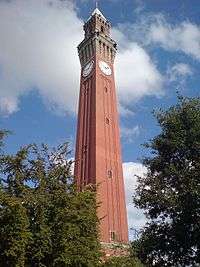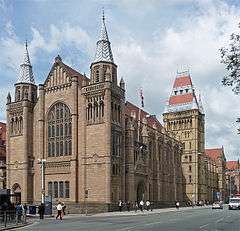Red brick university

Red brick university (or redbrick university) is a term originally used to refer to six civic universities founded in the major industrial cities of Great Britain in the 19th century. The term is now used more broadly to refer to British universities founded in the late 19th and early 20th centuries in major cities.[1] All of the six original redbrick institutions, or their predecessor institutes, gained university status before World War I and were initially established as civic science or engineering colleges.[2][3][4][5][6][7]
Whilst the term was originally coined as these institutions were new and thus regarded by the ancient universities as arriviste,[8] the description has since ceased to be derogatory with the 1960s proliferation of universities and the reclassification of polytechnics in 1992. The six institutions are members of the Russell Group (which receives two-thirds of all research grant funding in the United Kingdom).[9]
Origins of the term and use
The term red brick or redbrick was first coined by Edgar Allison Peers, a professor of Spanish at the University of Liverpool, to describe the civic universities (under the pseudonym "Bruce Truscot" in his 1943 book Redbrick University).[10] His reference was inspired by the fact that The Victoria Building at the University of Liverpool (designed by Alfred Waterhouse and completed in 1892 as the main building for University College, Liverpool) is built from a distinctive red pressed brick, with terracotta decorative dressings.[11] On this basis the University of Liverpool claims be the original "red brick" institution, although the titular, fictional Redbrick University was a cipher for all the civic universities of the day.[12][13][14]
While the University of Liverpool was an inspiration for the "red brick" university alluded to in Peers' book, receiving university status in 1903, the University of Birmingham was the first of the civic universities to gain independent university status in 1900 and the University has stated that the popularity of the term "red brick" owes to its own Chancellor's Court, constructed from Accrington red brick.[15][16] The University of Birmingham grew from the Mason Science College (opened two years before University College Liverpool in 1880), an elaborate red brick and terracotta building in central Birmingham which was demolished in 1962.[17]
Civic university movement
These universities were distinguished by being non-collegiate institutions that admitted men without reference to religion or background and concentrated on imparting to their students "real-world" skills, often linked to engineering.[18] In this sense they owed their structural heritage to the Humboldt University of Berlin, which emphasised practical knowledge over the academic sort.[19] This focus on the practical also distinguished the red brick universities from the ancient English universities of Oxford and Cambridge and from the newer (although still pre-Victorian) University of Durham, collegiate institutions which concentrated on divinity, the liberal arts and imposed religious tests (e.g. assent to the Thirty-Nine Articles) on staff and students. Scotland's ancient universities (St Andrews, Glasgow, Aberdeen and Edinburgh) were founded on a different basis between 1400 and 1600.[20]
The first wave of large civic red brick universities all gained official university status before the First World War, all of these institutions have origins dating back to older medical or engineering colleges and were located in the industrial centres of the late Victorian and Edwardian eras that required strong scientific and technical workforces.[20] These universities developed out of various 19th-century private research and education institutes in industrial cities. The 1824 Manchester Mechanics' Institute formed the basis of the Manchester Institute of Science and Technology (UMIST), and thus led towards the University of Manchester proper.[6] The University of Birmingham has origins dating back to the 1825 Birmingham Medical School.[2] The University of Leeds also owes its foundations to a medical school: the 1831 Leeds School of Medicine. The University of Bristol began with the 1876 University College, Bristol,[3] the University of Liverpool with a University College in 1881,[5] and the University of Sheffield with a university college in 1897.[7]
Combined English Universities was a university constituency in the UK Parliament created by the Representation of the People Act 1918 for graduates of Durham University or the six red bricks. Oxford, Cambridge, and London had already been enfranchised. Reading University was added to the Combined English Universities constituency in 1928.
| Name | University charter awarded | Predecessor institutions | Image | Notes |
|---|---|---|---|---|
| Victoria University | 1880 (defunct 1903) |
Owens College, Manchester (1851) Leeds School of Medicine (1831) University College Liverpool (1881) |
Victoria University was a federal college based in Manchester with satellite sites in Leeds and Liverpool. It was defunct by 1903 as Leeds and Liverpool sought independent university status which led to the formation of the new Victoria University of Manchester in 1903 and which merged into the University of Manchester in 2004. | |
| University of Birmingham | 1900 | Birmingham Medical School (1825) Mason Science College (1875) Mason University College (1898) |
 |
The first independent civic university to be awarded full university status by Royal Charter. |
| University of Liverpool | 1903 | University College, Liverpool (1881) |  |
|
| University of Manchester | 1903 (as Victoria University of Manchester) 2004 (as University of Manchester) |
Mechanics' Institute, Manchester (1824) Owens College, Manchester (1851) Victoria University of Manchester (1903) UMIST (1956) |
 |
The federal Victoria University existed between 1880-1903. Victoria University of Manchester gained royal charter as a new entity in 1903. UMIST formed in 1956 and merged with the Victoria University of Manchester in 2004 to form the current University of Manchester. |
| University of Leeds | 1904 | Leeds School of Medicine (1831) |  |
|
| University of Sheffield | 1905 | Sheffield Medical School (1828) University College of Sheffield (1897) |
 |
|
| University of Bristol | 1909 | University College Bristol (1876) |  |
Other institutions
Many institutions share similar characteristics to the original six civic universities, namely those in the second wave of civic universities before the advent of the plate glass universities in 1961. These universities differed from the red bricks in that they evolved from local university colleges rather than civic institutes and all previously awarded external Oxford University and University of London degrees before being granted full status after the First World War. These include the University of Reading, founded in the late 19th century as an extension college of Oxford University which was the only university to receive its charter between the two world wars and describes itself as a "red brick" university.[21][22] Queen's University Belfast, which became a civic university in 1908, also lays claim to the title having previously been established in 1845 as a college of the Queen's University of Ireland (later Royal University of Ireland). Many of the original constituent institutions of the University of Wales bear the "red brick" hallmarks: Aberystwyth; Bangor; Swansea; Cardiff. Certain constituent colleges of the University of London, such as Royal Holloway, Queen Mary and Goldsmiths College are also literally Victorian red brick in style.
Various other civic institutions with origins dating from the 19th and early 20th centuries have also been described as Red Brick: University of Dundee (originally an independent university college, before becoming a constituent college of the University of St Andrews), Birkbeck, University of London (founded in 1823), University of Exeter, University of Hull, University of Leicester, University of Nottingham, and University of Southampton (all originally university colleges preparing students for the examinations of the University of London), and Newcastle University (previously a college of the University of Durham).
In 1963, the Robbins Report recommended expansion of the British university system. The universities established after this report are often known as the 'Plate Glass' universities, although this more properly refers to those institutions already in the process of foundation at the time of the Robbins Report, starting with the University of Sussex in 1961.
See also
- Sandstone universities (Australia)
- Ancient Universities
- Ancient universities of Scotland
- Plate glass university
- Campus university
- New universities
References
- ↑ "A history of the HE environment". University of St Andrews. Archived from the original on 26 May 2007.
- 1 2 "Birmingham University Firsts". Retrieved 20 May 2009.
- 1 2 "About the University of Bristol". Retrieved 20 May 2009.
- ↑ "Origins of the University of Leeds". Retrieved 20 May 2009.
- 1 2 "About the University of Liverpool". Retrieved 20 May 2009.
- 1 2 "University of Manchester: History". Archived from the original on 24 February 2009. Retrieved 20 May 2009.
- 1 2 "About the University of Sheffield". Retrieved 20 May 2009.
- ↑ Peers, Edgar Allison (1943). Redbrick University.
- ↑ Russell Group: Home
- ↑ Mackenzie & Allan (1996). Redbrick University Revisited. Liverpool University Press. ISBN 0-85323-259-8.
- ↑ Feingold, Mordechai (2006). History of Universities, Vol. XXI/1. Oxford University Press.
- ↑ Allison Peers (under the pseudonym 'Bruce Truscot'), Edgar (1943). Redbrick University. Faber & Faber Ltd.
- ↑ "University of Liverpool". Russell Group website. Retrieved 19 July 2013.
- ↑ "University of Liverpool guide". Daily Telegraph. Retrieved 19 July 2013.
- ↑ "University of Birmingham Professorial Announcement" (PDF). Archived from the original (PDF) on 6 May 2014. Retrieved 20 June 2013.
- ↑ "Complete University Guide, University of Birmingham". Retrieved 20 June 2013.
- ↑ In Churchill's Shadow: Confronting the Past in Modern Britain. Retrieved 11 July 2013.
- ↑ Egiins, Heather (2010). Access and Equity, Comparative Perspectives (PDF). Rotterdam, Netherlands: Sense. p. 12. ISBN 978-94-6091-184-2. Retrieved 6 May 2014.
- ↑ "Humboldt University Structural Model and History". Retrieved 20 May 2009.
- 1 2 Sanderson, Michael (2002). The History of the University of East Anglia, Norwich. London: Hambledon & London. p. 3. ISBN 1852853360. Retrieved 6 May 2014.
- ↑ "The University's History". University of Reading. Retrieved 30 April 2009.
- ↑ "Facts and figures about the university". University of Reading. Archived from the original on 1 July 2013. Retrieved 19 July 2013.
Further reading
- Whyte, William. Redbrick: A Social and Architectural History of Britain's Civic Universities (2015).